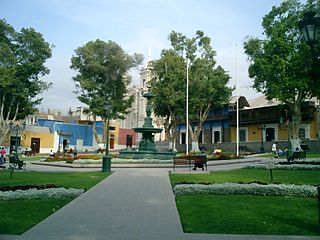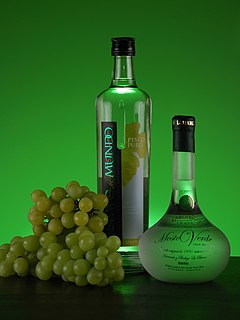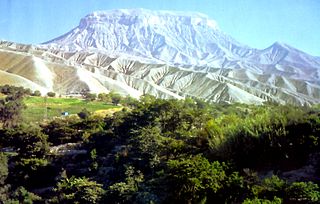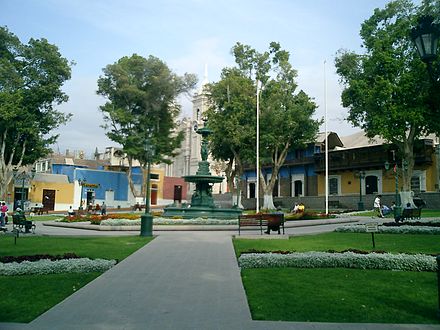
Pisco is a small city located in the Department of Ica of Peru, the capital of the Pisco Province. The city is around 9 metres above sea level. Pisco was founded in 1640, close to the indigenous emplacement of the same name. Pisco originally prospered because of its nearby vineyards and became noted for its grape brandy or pisco which was exported from its port. Pisco has an estimated population of 104,656.

Junín is a region in the central highlands and westernmost Peruvian Amazon. Its capital is Huancayo.

Mollendo is a town bordering the Pacific Ocean in southern Peru. It is located in the Arequipa Region and is the capital of both the Islay Province and the Mollendo District. Mollendo was the main port in the Peruvian southern coast until Matarani was developed about 50 years ago; the port of Mollendo only serves fishermen for the local economy currently and all the commercial shipping is done through Matarani 12 kilometers north; the old port is in ruins. From about 1830 to 1880 it was important in the Guano trade.

Qullasuyu was the southeastern provincial region of the Inca Empire. Qullasuyu is the region of the Qulla and related specifically to the native Qulla Quechuas who primarily resided in areas such as Cochabamba and Potosí. Most Aymara territories which are now largely incorporated into the modern South American states of northern Chile, Argentina, Peru and Bolivia were annexed during the reign of Sapa Inca Huayna Cápac in the sixteenth century.

Lunahuaná is a small town in the Cañete Province in Peru. The town lies about 187 km south of Lima in the Lunahuaná valley at the bank of Cañete River. Due to the unique landscape, Lunahuaná is a very popular destination for both Peruvians and foreign tourists. According to the 2017 census, there were 4,393 inhabitants.

Ilo is a port city in southern Peru, with 66,118 inhabitants. It is the second largest city in the Moquegua Region and capital of the Ilo Province.

Puquina is an extinct language once spoken by a native ethnic group in the region surrounding Lake Titicaca and in the north of Chile. It is often associated with the culture that built Tiwanaku.

The Mariscal Luzuriaga Province is one of 20 provinces of the Ancash Region in Peru. It was created by law 12541 on January 12, 1956 and named after the Peruvian marshal and Argentine general Toribio de Luzuriaga

The Mariscal Nieto Province is the largest of three provinces that make up the Moquegua Region of Peru. The capital of the province is the city of Moquegua.

The Pomabamba Province is one of twenty provinces of the Ancash Region in Peru. It was formerly called Pumapampa and today it is also known as "The City of Cedars". It is located at the left bank of the Pomabamba river, at 3,063 meters (10,049 ft) above sea level. It was created by law on February 21, 1861.

Osmore River system flows northeast to southwest in the Moquegua Region of southern coastal Peru. The river has its origin in the snow peaks of the Chuqi Ananta and Arundane mountains, at an elevation of 5,100 metres (16,700 ft). It changes names as it descends from the Andes: From its origin it is called the Moquegua, then Osmore in the middle valley as Rio Coscori and Rio Tumilaca including where the river disappears into subterranean channels, and further down in the lower reaches as Rio Ilo.

In Peru and other countries, pisco is a "designation of origin" that is reserved for the alcoholic beverage belonging to a variety of grape aguardiente produced in Peru since the late 16th century. It is the typical destillate of this country, elaborated from fermented wine of certain grapes, whose value has crossed its borders, as evidenced by the records of shipments made through the port of Pisco to Europe and other parts of the Americas since the 17th century, places such as England, Spain, Portugal, Guatemala, Panama and United States, from the mid-19th century.
Inka Tampu or Inkatampu is an archaeological site in Peru. It is located in the Cusco Region, La Convención Province, Vilcabamba District. The archaeological group is situated on top of a mountain named Inka Tampu (Inka Tambo).

Chuquiananta is a mountain in the Andes of southern Peru, about 5,300 metres (17,388 ft) high. It is situated in the Moquegua Region, Mariscal Nieto Province, Torata District, and in the Tacna Region, Candarave Province, Camilaca District. Chuquiananta lies south-west of Tutupaca volcano, south-east of Pomani.

Apacheta Limani is a mountain in the Andes of southern Peru, about 5,300 metres (17,388 ft) high. It is located in the Moquegua Region, Mariscal Nieto Province, Torata District, and in the Tacna Region, Candarave Province, Camilaca District. Apacheta Limani is situated south of the mountain Limani, northwest of the Tutupaca volcano, Chuquiananta and Huañuma, and northeast of Pomani. The Asana River originates near Apacheta Limani. It flows to the southwest.

Surehuayco and from Quechua Suri Wayq'u) is a mountain in the Andes of southern Peru, about 4,800 metres (15,748 ft) high. It is situated in the Moquegua Region, Mariscal Nieto Province, Torata District. It lies southwest of the mountain Iruma and east of Achucallani. Surehuayco is also the name of an intermittent stream north of the mountain.

Cerro Baúl is an ancient political outpost and ceremonial center settlement in Peru established by the pre-Incan empire called the Wari. It was evacuated after a siege by the Inca Empire in about 1475. Cerro Baúl is a terraced mountain, 2000 feet above its surroundings, with a settlement on the cliff tops themselves and in the immediate surroundings. Among other finds are the remnants of a brewery and large buildings that may have been used for ceremonial feasting. There is evidence of damage that has been interpreted as a careful and deliberate destruction, by the city's own people, of several buildings prior to the mesa's being vacated.



























